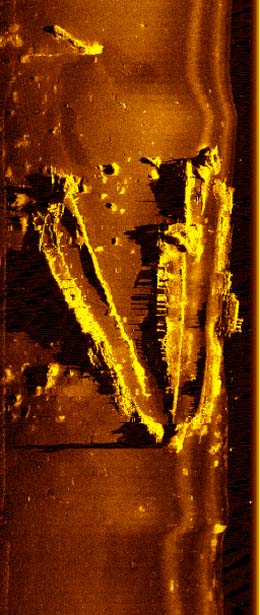On April 4, 1923, wooden sailing vessel turned whaling supply barge Fresno burns at a wharf on Meydenbauer Bay. After usable machinery is removed and sold as scrap, Fresno is scuttled in 190 feet of water, just north of today's Evergreen Point Bridge. A subsequent lawsuit reaches the Washington State Supreme Court.
Sailing Vessel Turned Support Barge
W. Rogers of Bath, Maine, built the 1,244-ton sailing vessel Fresno in 1874. After operating for years serving Atlantic ports, she sailed around Cape Horn for use in Pacific waters and was eventually reconfigured as a barge.
North Pacific Sea Products (NPSP) bought her in 1914. North Pacific Sea Products, a Canadian firm whose American affiliate was known as American Pacific Whaling Co., used the Fresno to carry supplies from Seattle to a whaling station at Akutan, Alaska, and to haul whale oil and fertilizer on the return trip to Seattle.
The Lake Washington Ship Canal and locks were completed in 1917. Lake Washington's shoreline dropped nine feet and the lake became easily accessible to saltwater vessels. In 1919, North Pacific Sea Products (American Pacific Whaling Co.) began storing its whaling ships at Meydenbauer Bay (Bellevue) during the off-season.
In the fall of 1922, the firm brought the Fresno into the lake and laid her up on the northern side of its wharf there. Aided by steam winches, the Fresno's bow was dragged as close to shore as possible, where it sank into the soft, gooey mud. The Fresno was embedded there as if in quicksand. She was equipped with a steam donkey, steam winches, and other machinery for a new wharfside support role.
The Fire
In the early morning of April 4, 1923, a fire broke out spontaneously in the vessel's hold, which the Marine Digest described as having been (whale) "oil soaked." Initially, the passenger ferry Leschi and a small tug struggled to pull the Fresno away from the wharf but thick mud held her fast. Then the whaling firm's steamers Aberdeen, Moran, and Westport joined the tug and finally the four succeeded in wresting the Fresno from the goo and away from the burning wharf.
The fire eventually burned itself out and the scorched machinery tumbled into the Fresno's hold, hissing and steaming as it settled. Though the vessel was still afloat (barely), investigators declared the charred hull a total loss.
The Fresno as Scrap
Interested in the scrap value, an owner of the wrecking and scrap firm Nieder & Marcus inspected the wreck and its equipment on April 6, 1923, and decided to purchase the hulk. On April 9, Nieder & Marcus accepted a bill of sale for the vessel. The price was merely $1, but the bill of sale specified that Nieder & Marcus "... will entirely and completely remove the said Fresno from Meydenbauer Bay within thirty days from this date."
Nieder & Marcus tried to rescind the purchase a few days later because the Fresno had settled to the bottom. Now, dewatering and removal costs would exceed the machinery's scrap value. Nieder & Marcus wanted out of the deal.
The wreck just sat, so after the 30 days had passed North Pacific Sea Products removed and sold the scrap machinery and paid another operator $2463.16 to refloat the Fresno, tow her out into 190 feet of water and finally fill her with gravel until she sank to the bottom. This was considered the most efficient and economical disposal method.
North Pacific Sea Products sued Nieder & Marcus for the scuttling costs minus the proceeds from the scrap machinery's sale. Finding that Nieder & Marcus had breached the contract, the trial court held for North Pacific Sea Products. Nieder & Marcus appealed to the Washington State Supreme Court, which affirmed the trial court's original ruling.
Eighty Years Later
The Fresno sat unnoticed on the cold, black lakefloor until October 2003. At that time, scientists working for Golder and Associates surveyed the lakefloor for Washington State Department of Transportation (WSDOT) in preparation for the project of building a second SR-520 bridge. They spotted a burned vessel on their sonar equipment. At first it was believed to be the Fresno, but upon closer investigation divers determined that the wreck was a steamer, not a sailing vessel.
Renewed interest in the Fresno led to further sleuthing, and in December 2003, sonar scans revealed that the sailing ship lay farther south on the lakefloor, closer to Meydenbauer Bay. Evidence of fire damage was visible, and the boat had split laterally, possibly upon impact with the bottom after it sank.
The ship near the bridge remains a mystery. Using hardhat divers, Golder videotaped the wreck so WSDOT can determine its historical or environmental relevance and whether WSDOT should leave the vessel or move it to make way for the SR-520 Bridge Replacement Project.

